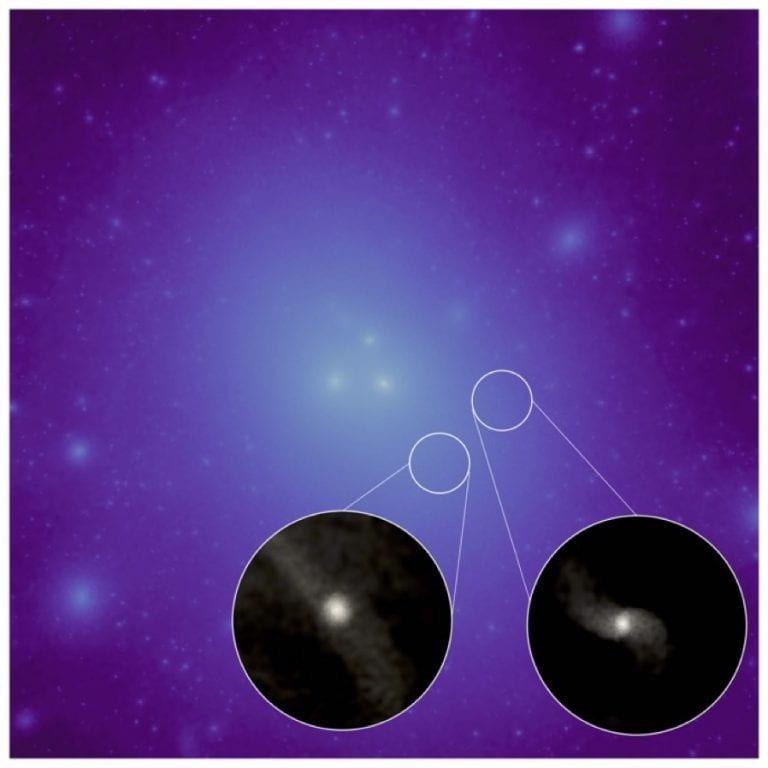An international group headed by astrophysicists from the University of California (UCI), Irvine and Pomona College report how, when small galaxies collide with bigger ones, the bigger galaxies could strip the smaller galaxies of their dark matter.
 Dark matter distribution in a simulated galaxy group, with brighter areas showing higher concentrations of dark matter. Circles show close-up images of the stellar light associated with two galaxies lacking dark matter. If these galaxies had dark matter, they would appear as bright regions in the main. Image Credit: Moreno et al.
Dark matter distribution in a simulated galaxy group, with brighter areas showing higher concentrations of dark matter. Circles show close-up images of the stellar light associated with two galaxies lacking dark matter. If these galaxies had dark matter, they would appear as bright regions in the main. Image Credit: Moreno et al.
Dark matter cannot be seen directly, but astrophysicists think it exists because, without its gravitational effects, they could not describe things like the motions of a galaxy’s stars.
It is a mechanism that has the ability to describe how galaxies may be able to survive without dark matter — something once thought impracticable.
It began in 2018 when astrophysicists Shany Danieli and Pieter van Dokkum of Princeton University and Yale University noted two galaxies that looked to exist without the majority of their dark matter.
We were expecting large fractions of dark matter. It was quite surprising, and a lot of luck, honestly.
Shany Danieli, Study Co-Author and Astrophysicist, University of California
The lucky discovery, which van Dokkum and Danieli published in Nature in 2018 and Astrophysical Journal Letters in 2020, threw the galaxies-need-dark-matter paradigm into disarray, potentially upending what astrophysicists had come to regard as a standard model for how galaxies work.
It’s been established for the last 40 years that galaxies have dark matter. In particular, low-mass galaxies tend to have significantly higher dark matter fractions, making Danieli’s finding quite surprising. For many of us, this meant that our current understanding of how dark matter helps galaxies grow needed an urgent revision.
Jorge Moreno, Study Lead Author and Astronomy Professor, Pomona College, University of California
The researchers ran computer models that simulated the evolution of a section of the universe — one nearly 60 million light years across — from shortly after the Big Bang to the present day.
The researchers discovered seven galaxies devoid of dark matter. Following numerous collisions with neighboring galaxies that are 1,000-times more massive, they were stripped of the majority of their material. This leaves behind nothing but stars and a few residual dark matters.
It was pure serendipity. The moment I made the first images, I shared them immediately with Danieli, and invited her to collaborate.
Jorge Moreno, Study Lead Author and Astronomy Professor, Pomona College, University of California
Robert Feldmann, a professor at the University of Zurich who developed the new simulation, stated that “this theoretical work shows that dark matter-deficient galaxies should be very common, especially in the vicinity of massive galaxies.”
James Bullock, from UCI, an astrophysicist who is a world-renowned expert on low-mass galaxies, explained how he and the team did not construct their model just so they can make galaxies without dark matter — something he said makes the model powerful since it was not developed in any way to establish the collisions that they eventually found.
“We don’t presuppose the interactions,” stated Bullock.
Confirming that galaxies lacking dark matter could be described in a universe where there is lots of dark matter is a sigh of relief for scientists like Bullock, whose career and everything he unearthed therein hinges on the dark matter being the thing that makes galaxies act the way they do.
Bullock stated, “The observation that there are dark matter-free galaxies has been a little bit worrying to me. We have a successful model, developed over decades of hard work, where most of the matter in the cosmos is dark. There is always the possibility that nature has been fooling us.”
However, Moreno stated, “you don’t have to get rid of the standard dark matter paradigm.”
As the astrophysicists now know how a galaxy might lose its dark matter, Moreno and his associates hope that the findings inspire scientists who look at the night sky to seek real-world enormous galaxies that may be in the process of stripping dark matter away from smaller ones.
Bullock stated, “It still doesn’t mean this model is right. A real test will be to see if these things exist with the frequency and general characteristics that match our predictions.”
As part of this new work, Moreno, who has indigenous roots, received permission from Cherokee leaders to name the seven dark matter-free galaxies discovered in their simulations in honor of the seven Cherokee clans: Bird, Blue, Deer, Long Hair, Paint, Wild Potato and Wolf.
“I feel a personal connection to these galaxies many people of indigenous ancestry were stripped of our culture. But our core remains, and we are still thriving,” stated Moreno, who added that this is similar to how the more enormous galaxies robbed the smaller galaxies of their dark matter.
This study was financially supported by the National Science Foundation, sabbatical leave support for Moreno from Pomona College and the Harry and Grace Steele Foundation, and, for Danieli, from NASA through Hubble Fellowship grant HST-HF2-51454.001-A awarded by the Space Telescope Science Institute, which is functioned by the Association of Universities for Research in Astronomy, Incorporated, under NASA contract NAS5-26555.
The other collaborators of the study include Francisco Mercado, Courtney Klein and Zachary Hafen, all from UCI.